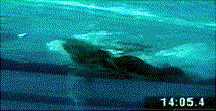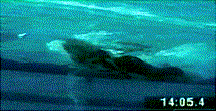HOW CHAMPIONS DO IT
Researched, produced, and prepared by Brent S. Rushall,
Ph.D., R.Psy.

HANNAH STOCKBAUER AT 1320 m OF HER GOLD MEDAL 1500 m RACE AT THE 2003 WORLD CHAMPIONSHIPS IN BARCELONA (2-BEAT KICK)
Each frame is .1 seconds apart. Hannah Stockbauer's time for the 1500 m race was 16:00.18. This analysis is unique because it shows the swimmer's stroke while executing a 2-beat kick (as distinct from the 6-beat kick demonstrated during her 400 m race analysis).
This stroke analysis includes a moving sequence in real time, a moving sequence where each frame is displayed for .5 of a second, and still frames.
The following image sequence is in real time. It will play through 10 times and then stop. To repeat the sequence, click the browser's "refresh" or "reload" button.

The following image sequence shows each frame for half a second. It will play through 10 times and then stop. To repeat the sequence, click the browser's "refresh" or "reload" button.

At the end of the following narrative, each frame is illustrated in detail in a sequential collage.
Notable Features
Frame #1: The left hand is just breaking the water surface to initiate the entry. The right arm is still propelling backward and partly upward. It is hard to see because it has been too deep in the water. This frame captures a sudden vertical repositioning to make the arm more powerful and direct in the latter part of the pull. The power of the swimmer's pull can be seen by the size of the drag-pocket water swirl (the column of white water) left behind by the repositioned hand/forearm. The swimmer is well streamlined with legs trailing, as is characteristic of a two-beat kicker.
Frame #2: The left arm enters and stretches forward. The shoulders begin to roll down on the left side. The right hand and forearm are still pushing backward with a vertical propelling surface. The legs still trail.
Frame #3: The left arm and shoulder are at full extension and the swimmer begins to "lean" downward. As the shoulders and hips roll to the left, the left foot and leg rise to retain streamline. The amount of roll to the left might be influenced by the swimmer having turned her head to the right to breathe.
Frame #4: The left arm is pressed directly downward. The white turbulent pocket on top of the arm indicates the vertical movement. The right leg kicks to counterbalance the left arm vertical force component. The right arm exits and assists body rotation.
Frame #5: The left arm begins to change to a propulsive action. Minor medial rotation of the upper arm and flexion of the elbow and wrist occur. Rotation of the body to the left continues.
Frame #6: The left elbow bends markedly as abduction of the upper arm occurs. The drag pocket coming off the left arm shows that the whole arm, constitutes the propelling surface. Breathing is completed and the head begins to return. The left leg is bent and at the surface poised to execute the next kick when the right arm enters the water.
Frame #7: The left arm is relatively deep with the elbow well bent and the upper arm transitioning from abduction to adduction. However, if there is no adjustment in the arm, the remainder of the pull would have a large vertical force component as its path would be like that of the fourth quadrant of a circle. The whole of the left arm is providing propulsion as the turbulent pocket of the drag force attests. The head has returned very quickly and looks slightly forward. The right arm is recovering very quickly. The left leg prepares to kick.
Frame #8: There is a unique, but not particularly worthy feature of Hannah Stockbauer's stroke display in this frame. The right arm has entered quickly. Since the right shoulder will be following the arm, that is, it will be going down, the left shoulder rotates upward as a consequence. The left shoulder rises abruptly leaving the left arm down and virtually eliminating any strong adduction of the upper arm as part of force generation. The left elbow moves very quickly to be alongside and below the body. The rise of the left shoulder also causes the propelling surfaces of the left arm to suddenly slip upward. Here the hand is 8-10 inches above the drag-pocket turbulence caused in the previous frame. The upward slip causes a momentary loss of force production. If a force curve were plotted for this stroking form, it would have two peaks, much the same as does Alexandre Popov's force curve. The swimmer is well streamlined. The left leg kicks to produce a counterbalancing vertical force for the right arm entry.
Frame #9: Left arm propulsion continues with the hand/forearm surface with the contribution from the upper arm having ceased after frame #7. The right arm and shoulder extend forward and produce a drag force with a large vertical and smaller backward force component. Some movement of the head has caused momentary turbulence, which is flowing to the shoulders. The left leg kicks to counterbalance forces created by the right arm.
Frame #10: The left arm has pushed a long way back. The left elbow exits leading the forearm to initiate the recovery. The right arm presses directly downward. The left foot drags slightly down to act as a form of "trim tab" to counterbalance the vertical force components of the right arm action. The left foot has a large pool of turbulent water between it and the surface. The position of this drag "pocket" is evidence that a kick does not propel in swimming freestyle. The role it plays here is to generate a vertical force that counterbalances forces developed by the arm that has just entered the water.
Frame #11: The right arm continues to press down while beginning to bend at the elbow. The left leg is still "dragging" to offset the vertical force components produced by the right arm. Ideally, at this stage of a crawl stroke, the upper arm should have medially rotated and the elbow flexed to almost 90 degrees. Hannah Stockbauer's stroke is far from being beyond criticism.
Frame #12: The right arm finally is propelling backward, although with the propelling surfaces offset from vertical. The continuing vertical force component requires the left leg still to be "dragged". However, the swimmer's streamline in this whole series is very good.
Frame #13: As with the left arm, the right arm pull is at its deepest. Although its propulsion is quite effective here, as demonstrated by the total arm drag pocket of turbulence, for effective propulsion to continue, the arm has to be raised abruptly. The left arm is recovering fast. At this stage of the stroke, the shoulders are still rotating to the right.
Frame #14: The right shoulder is at its deepest in the stroke but the propulsive arm has been raised to begin an effective latter phase of the stroke.
Frame #15: The stroke cycle is repeated with a position very similar to that displayed in frame #1 being demonstrated.
Hannah Stockbauer is the best women's distance swimmer in the world. However, she does not hold any world records. This analysis has been critical. It indicates there are some aspects of technique that if changed, would promote faster and/or more efficient swimming.
Her swimming displays excellent streamline, reasonably balanced stroking (one arm begins a preparatory-to-pulling action as the other arm finishes), good two-beat kicking form and rate, and a good back-half of her propulsive movements. However, she needs to reconcile the front half of her stroking patterns with better mechanics; those that will allow earlier effective propulsion and consistent force application. Her underwater stroke is typical of a swimmer who tries to reach forward and down to develop a "long" stroke. The depth of the arm pull is not modified in concert with considerable body roll. Consequently, when each shoulder is relatively deep, the still quite long propelling arm is too deep. In each case, the pulling arm has to be adjusted by slipping upward so that a more direct form of propulsion can be achieved in the latter part of the stroke. The stroking path of this latter feature is displayed by Alexandre Popov, most notably with his left arm, in Article #33 in the Swimming Science Bulletin.
Hannah Stockbauer would do well to copy the early arm actions of Ian Thorpe, Brooke Bennett, Claudia Poll, and the right arm of Jane Evans so that the actions of both of her arms would be singularly propulsive.

Return to Table of Contents for this section.






